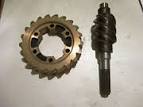Bronze Safe Castor Oil for 404 Rear Differential
- tlangton7
- Mar 1, 2017
- 3 min read
On left, typical 404 sedan rear axle / differential with fill plug on top and drain plug on bottom (Do not need to remove 4 bolted plate unless leaking). On right, cleaned Cabriolet rear axle/differential with top fill plug removed and rear plate removed (bottom drain plug not pictured). Plate should be resealed with Loctite or silicone joint when replaced.
Our 404s (and the 403 and 203s before them) have a large bronze crown gear and steel worm or screw drive that powers the rear drive train. Because of the large bronze gear and high temperatures and pressure in the differential, Peugeot used and recommended a 90W castor oil (Esso Gear Oil VT) that would protect and not degrade bronze and lubricate efficiently at the same time.
Photos of new bronze crown gear available at Peugeot Classic Museum (left) and crown gear with steel worm (or screw) drive (right)
Newer mineral or synthetic based gear, differential or transmission oils contain EP (extreme pressure) additives (usually sulfur and phosphorous) that break down the bronze crown gear over time. It causes pitting and chipping in the crown gears bronze teeth which then leads to a loud rumbling noise and/or jerking and play when driving gears are engaged. It eventually becomes intolerable and in extreme cases can seize rear drive train. Because of the lack of availability of castor oil and lack of knowledge of Peugeot 404 differential bronze gear in North America, this often became a common problem in North American cars. Many mineral or synthetic EP oils were added unknowingly or oils claiming to be bronze or brown metal safe were used, but often were not and degraded the large and sensitive 404 bronze gear. One solution was/is often to rotate the crown gear to the less used side, but this may or not work depending on the extent of the degradation. New crown gears can also be found, but they are expensive ($500+). Best thing to do is flush unknown or old differential oil and maintain often with fresh castor oil.
The 404 rear axle takes about 1.4 litres so if you know you have original castor oil, one jug should be enought to top up and last for awhile. If you are not sure what type of oil you have now or want to change, you probably could get by with just 1 can, but could use 2 jugs if you want longer supply (the flat rate priority postage is the same for 1 or 2 jugs). The club bulk order will be arriving in April in USA and Mike Aube has an existing supply for Canadian members (maube@idirect.com). You can pre-order and help us pay for the initial shipment by ordering here: Castor Oil Order
Vegetable and mineral or synthetic oils are not compatible and should not be mixed. When they are mixed they form a white waxy goop in the rear axle that is difficult to remove and damaging. If you are not sure what oil you have in your rear axle now, simply flush and clean your rear axle before adding new castor. Drain your existing oil by removing the top and bottom plugs of your differential and draining old oil. Plug bottom and add kerosene. Spin the lifted rear wheel in neutral with reservoir full of kerosene and then drain. Repeat the same procedure next with denatured alcohol. Wait a few hours and then add a little castor oil and move wheel again and then drain out small amount of oil and recycle. Finally, fill with fresh castor and you are set for awhile just topping off when needed.
We have arranged a bulk import from France of the recommended 404 rear differential castor oil made by Yacco in 2L metal cans- SAE 90 / API GL-2. This oil is a 100% vegetal castor oil formula and safe for the bronze crown gear and steel worm drive found in classic 203, 403, and 404 rear axles. We are able to offer the oil for members for around $25 + shipping costs. You can pre-order for April delivery here: Castor Oil Order
Specifications: 2L, API GL-2, SAE 90 Advantages: - Vegetable based for a perfect compatibility with bronze and copper materials - Excellent anti-wear and anti-corrosion protection for worm / screw gears at extreme pressure & heat















Comments